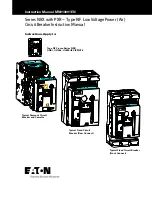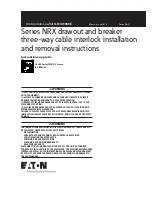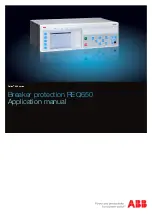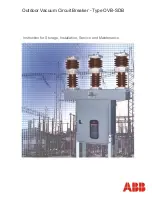
SECTION 7 -Breaker Maintenance (Cont.)
7.5.1 REPLACEMENT
Figs. 22, 23, 24, and 25 show the primary disconnect
assembly breakdown . Refer to these illustrations when
replacing the disconnects. Note the following details:
Fig. 25 - The position of the spacer in the breaker stud.
The hole in the spacer must be positioned as
shown so it will align with the holes in the clip.
Fig . 24 - The engagement of the fingers with the re
tainer. Also the location of the 'bowtie' spacers in
the fingers, both upper and lower.
Fig . 22
&
23 - The position of the upper and lower
retainers and, again, the 'bowtie' spacers.
7.5.2 ADJUSTMENT
The primary disconnect assembly is factory adjusted to
apply a force of 85-1 05 pounds on a 1 /2 thick copper bar
inserted between the upper and lower fingers. After instal
lation of the disconnect assembly this force range is ob
tained by tightening the locknuts to set the dimension
shown in Fig. 26 . 766" to .797" Note that this dimension
is measured between the top of the retainer and the
underside of the washer. Also note that no bar is inserted
between the fingers when setting this dimension.
FIG. 26 - PRIMARY FING E R ADJ USTMENT
7.6 AUXILIARY SWITCH
All electrically operated breakers and manual breakers
having shunt trips are supplied with auxiliary switches.
Depending upon the requirements of the breaker's applica
tion, the switch may contain from two to six stages. Usually,
each stage has one "A" contact and one "B" contact. "A"
contacts are opened or closed as the breaker is opened or
closed. "B" contacts are the reverse of this.
The auxiliary switch is mounted on the upper side of the
mechanism frame as shown in Fig. 27. A crank on the main
shaft operates the switch through an adjustable link which
connects it to the switch crank. The switch can be a GE
type "SB- 1 2" or Electro Switch Type "1 01 " .
22
FIG. 27 - AUXILIARY SWITCH LIN KAG E
7.6.1 REPLACEM ENT
Either switch type may be d ismounted by removing the
two bolt screws which fasten it to the mechanism frame.
The GE SB-1 2 replacement switch should have its
crank shaft set so that the arrow head on the end of the
shaft points as shown in Fig. 28A when the breaker is
open.
The Electro Switch replacement should have its crank
shaft set so that the horizontal line on the end of the shaft
is as shown in Fig. 288 when the breaker is open.
ARROW HEAD
FIG. 28A - GE SB-1 2
CRANK SHAFT POSITION
FIG. 288 - ELECTRO
SWITCH C RANK S HAFT
If a switch is added to a breaker having none, the ad
j usting link will also have to be installed. This is connected
to the pin on the crank which is attached to the main shaft.
It is secured by means of a cotter pin.
7.6.2 ADJUSTMENT
GE SB-12
If a new adjustable l i n k is i nstalled, its length should b e
set, before installing, a t 6.375 i nches, between p i n centers.
After installing a new switch, its operation should
be
checked. Viewing the switch from above, the contacts
toward the front of the breaker are normally the "B" con
tacts. Even if a special switch is used, it is always the case
that the first two stages nearest the crank have the "B"
contacts to the front, and the "A" contacts towards the
back. "A" contacts are closed when the breaker is closed.
"
B
"
contacts are closed when the breaker is open.
www
. ElectricalPartManuals
. com












































